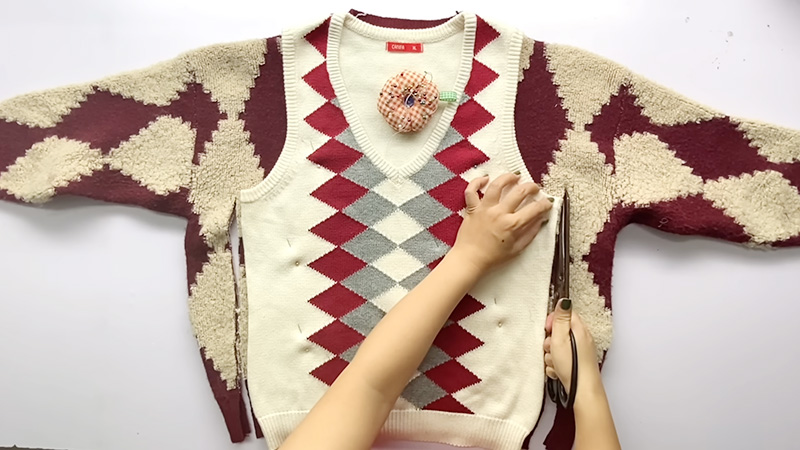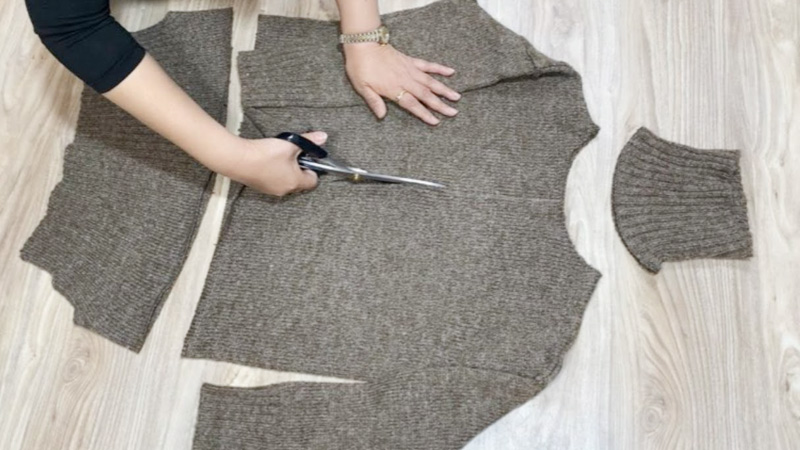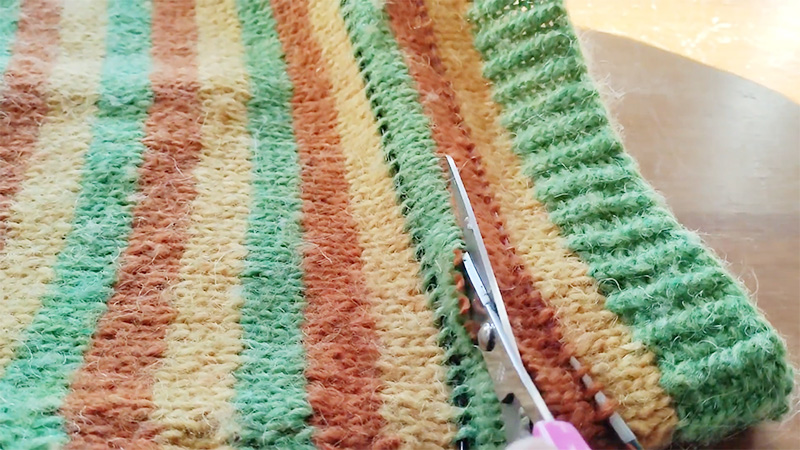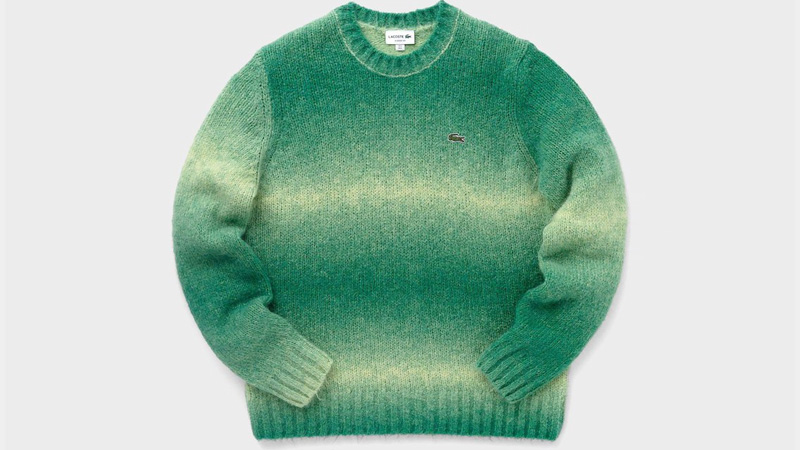The art of cutting a knitted sweater can be both a transformative and daunting undertaking.
Whether you’re looking to resize, restyle, or salvage a cherished garment, understanding the techniques and precautions involved is crucial.
Knitwear, with its delicate stitches and potential for unraveling, demands a careful hand and precise execution.
In this guide, we will explore the step-by-step process of cutting a knitted sweater, from selecting the right tools to reinforcing and finishing the edges.
By the end, you’ll have the knowledge and confidence to embark on this creative journey, giving your knitted sweaters a new lease on life and a personalized touch.

How to Cut Knitted Sweater?
Cutting a knitted sweater may seem counterintuitive and potentially risky, but there are situations where it becomes necessary.
Whether you want to resize a too-large sweater, salvage a damaged section, or repurpose an old knit into something new, knowing how to cut a knitted sweater with precision and care is essential.
Follow these steps to ensure a successful cutting process:
Materials and Tools Needed
- Knitted Sweater.
- Sharp Scissors.
- Pins or Clips.
- Measuring Tape or Ruler.
- Sewing Machine or Needle and Thread.
- Fusible Interfacing (optional).
Steps to Cut a Knitted Sweater:
Plan and Measure
When planning your cut, consider the intended purpose of the sweater. For instance, if you’re resizing it to fit better, take measurements from a well-fitting sweater you already own.
Use chalk, fabric markers, or removable pins to mark your measurements accurately on the sweater. Double-check these measurements before proceeding.
Secure the Sweater
Lay the sweater flat on a clean, flat surface. Ensure that it’s smooth and free from wrinkles.
To prevent the knitted fabric from unraveling while you cut, use pins or clips to secure the sweater just above the marked cutting line.
Position the pins or clips perpendicular to the edge to minimize the risk of snagging.
Cutting
Carefully cut along the marked line. Take your time and use slow, deliberate movements to achieve a smooth, even cut. Avoid any sudden jerks or tugs that might distort the knitting.
If you’re removing a damaged section, cut slightly below the damaged area to ensure complete removal.
Prevent Unraveling
Preventing unraveling is crucial to maintaining the integrity of your sweater. Use a whipstitch or blanket stitch along the cut edge.
If you have access to a sewing machine, use a zigzag or overlock stitch along the cut edge. Adjust the stitch width and tension to suit your fabric.
Finish the Edges (Optional)
For a polished look, consider adding ribbing or other trim to the cut edge. Measure and pin the trim carefully to ensure an even finish.
Sew it in place using a matching thread color for a seamless look.
Try on and Adjust
After finishing the cutting and securing the edges, it’s essential to try the sweater on again.
Pay close attention to the fit and how the cut area drapes. If you find any issues or areas that need further adjustments.
Care Instructions
Keep in mind that the cut edge may require special care. Handwashing the sweater in cold water and gentle handling can help maintain the integrity of the cut area.
Avoid excessive stretching or pulling, which can cause distortion.
How Do You Cut the Sweater Without Unraveling It?

Cutting a sweater without unraveling it can be a delicate process, especially if you’re dealing with a knitted fabric.
Here’s a step-by-step guide on how to cut a sweater without causing it to unravel:
Mark Your Cutting Line
Begin by determining where you want to cut your sweater. Use a measuring tape to ensure accuracy and mark the cutting line with fabric chalk or a water-erasable fabric marker. Take your time to make sure it’s in the right position.
Reinforce the Area with Stitches
To prevent unraveling, reinforce the area along the cutting line. You have two options:
Machine Stitch
If you have a sewing machine, use it to create a straight stitch along the marked cutting line. Ensure you backstitch at the beginning and end to secure the stitches.
Hand Sewing
If you don’t have a sewing machine, use a hand-sewing needle and thread to make a simple running stitch along the cutting line. Knot the thread securely at the beginning and end to hold the fabric together.
Cut Carefully
Now, with the reinforced stitches in place, use sharp scissors to carefully cut along the marked cutting line.
The stitches will act as a barrier, preventing the fabric from unraveling as you cut. Take your time to ensure a clean and even cut.
Finish the Edges (Optional)
If you want to give the cut edge a polished look and added stability, consider folding it over and sewing a hem using a sewing machine or hand-stitching.
You can also use a zigzag or overlock stitch to finish the edge. This step is optional but can enhance the sweater’s appearance.
Press and Block (if necessary)
After cutting and optionally finishing the edges, you may need to press the sweater with an iron to remove wrinkles and creases.
Depending on the yarn and knit pattern, you might also want to block the cut edge to ensure it lays flat and matches the rest of the sweater.
Inspect and Wear
Carefully inspect the cut sweater to ensure it meets your expectations. If you’re satisfied with the result, you can confidently wear your customized garment.
Which Types of Knitted Sweaters Do You Cut?

You can potentially cut and alter various types of knitted sweaters, but the ease and success of the process can vary depending on the specific type of knit, yarn, and construction.
Here are some common types of knitted sweaters that you can consider cutting:
Plain Stockinette Stitch Sweaters
Sweaters knitted in a simple stockinette stitch pattern (alternating rows of knit and purl) are relatively easy to cut and alter. However, you’ll still need to take precautions to prevent unraveling.
Ribbed Sweaters
Ribbed sweaters, which have a textured pattern of alternating knit and purl stitches, can also be cut and altered. Be sure to reinforce the edges before cutting.
Sweaters with Garter Stitch Edges
Some sweaters feature garter stitch edges (knitting every row), making it easier to cut without unraveling. These edges can provide a natural barrier to fraying.
Sweaters with Cables or Texture Patterns
Sweaters with intricate cable or texture patterns can be more challenging to cut and alter.
You may need to be extra cautious and consider how the design will be affected.
Sweaters with Ribbing at the Hem, Cuffs, and Neck
Sweaters that have ribbed or textured patterns only at the hem, cuffs, and neck can be easier to alter since you can cut above or below these areas.
Tips and Precautions

Here are the tips and precautions summarized for cutting a knitted sweater:
Measure Twice, Cut Once
Before making any cuts on your knitted sweater, double-check your measurements. Accuracy is crucial, as a small mistake can result in an irreversible alteration.
Measure the length, width, or any other dimensions you plan to change, and ensure your markings are precise.
Sharp Scissors
Using sharp scissors is essential when cutting a knitted sweater. Dull scissors can snag and damage the delicate fabric, leading to a messy result.
Invest in high-quality fabric scissors or have your scissors professionally sharpened before starting your project.
Sewing Machine Test
If you plan to sew along the cut edges of your sweater to prevent fraying, it’s essential to test your sewing machine settings first.
Use a spare piece of knitted fabric to experiment with stitch length, tension, and thread. This practice ensures that your sewing will be smooth and even when working on your sweater.
Patience is Key
Rushing through the cutting and sewing process can lead to errors and a less-than-desirable outcome.
Knitted fabric can be delicate and stretchy, so take your time to make precise cuts and sew carefully along the edges. A measured approach will yield a cleaner and more professional result.
Seek Expert Advice
If you’re uncertain about how to cut and alter a knitted sweater, consider reaching out to experienced knitters or seamstresses for guidance.
They can offer valuable tips, techniques, and even hands-on assistance if needed. Learning from those with expertise can boost your confidence and ensure a successful project.
FAQs
Not necessarily. The ease of cutting without unraveling depends on the knit pattern, yarn type, and your skill level. Some sweaters are more forgiving than others.
It’s best to use sharp fabric or sewing scissors to ensure clean cuts and minimize fabric damage.
Yes, you can alter the size of a sweater by cutting and sewing the edges, but it requires precision and careful stitching to achieve a professional result.
While a sewing machine can make the process easier, you can also hand-sew the edges to prevent fraying if you don’t have access to a sewing machine.
If you’re uncertain about the process, seek advice or assistance from experienced knitters or seamstresses.
To Wrap Up
Cutting a knitted sweater is a skillful endeavor that offers a creative means of altering and personalizing your wardrobe.
While the process may seem daunting, it is entirely achievable with the right tools, techniques, and a meticulous approach.
By measuring accurately, using sharp scissors, reinforcing the edges, and finishing them neatly, you can confidently modify the length, size, or design of your sweater.
It’s essential to handle each step with patience and care to prevent unraveling and achieve a polished result.
Additionally, seeking guidance from experienced knitters or seamstresses can provide invaluable insights and ensure a successful outcome for your sweater-cutting project.
Leave a Reply